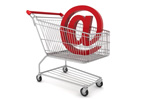Written by Raúl Carrión
Índice

This idea is usually diluted when we check all the aspects that we must control for our online business to be successful, but the truth is that it is not so complicated: we just have to divide the business planning into logical parts, trying to do our best in each one of them.
Product
We’re going to sell on the Internet, great, but… What are we going to sell? Contrary to what has been said in super-optimistic 2.0 circles, we cannot succeed on the Internet if we do not offer the right product. To find out if our product is suitable, we should ask ourselves the following questions:
Is my product competitive?
That is, does it have the necessary features to be at least as attractive as competing products?
To answer that question we will have to do a competitive study and check whether we can compete on price or value. We must take into account that the Internet makes it easy for the buyer to compare products prior to purchase, therefore, if we set a price much higher than the competition, we have little chance of selling.
Can my product transit without problems?
At this point, we must ask ourselves if there are any issues that may complicate the delivery of our product, these are the most common issues:
Product shelf life
If our product has a limited shelf life, we must have a high turnover and very short shipment times. In addition, the price of the product must assume the costs of the products that end up being discarded.
Refrigerated products
The major disadvantage of this type of product is that it makes storage and shipping more expensive.
Fragile products
They increase the number of returns, and therefore, an increase in the cost of shipping associated with the order.
Customers
Once we have defined the portfolio of products we want to sell, we will analyze our potential customers.
How do they search for our product?
The same product or service can be searched for in multiple ways based on socio-demographic factors: age, gender, nationality, economic level, education, etc.
To find out how people search for us, we can use Google’s keyword suggestion tool(Google Keyword Planner), which will provide us with three relevant pieces of information when we enter the name of our products:
- Similar terms used by our potential customers.
- Number of local and global searches for those search terms.
- Competition for those search terms.
Knowing the volume of demand and its trend
We will use Google Trends to know how the demand evolves and if it has seasonality, it will also inform us of:
- Trend of search terms
- Cities where they are most wanted
- Related search terms
Logistics
The next step is to plan the logistics of our online store: how we are going to store the product and how we are going to serve it.
Storage type
There are three possibilities for storing the product:
- Store it ourselves
- Request it to the distributor at the time of purchase.
- Hire a warehousing company
Our decision will vary based on the costs we can bear and the delivery time the end buyer can afford.
Transportation
We will carry out a study of the different transport companies specialized in e-commerce. Their prices will vary depending on the nature of the product, the delivery zones and the delivery time.
Legal issues
As it is a Web site, we must comply with the data protection law and have a legal note section where the processing of data and the conditions of purchase are informed.
In addition, we must register as self-employed or as a company as soon as we exceed the minimum interprofessional wage in sales, i.e., from the beginning.
Web Application
Once the previous questions have been solved, we will start working on our online store itself.
Domain
The first step is to choose a good domain name that is easy to remember, easy to communicate, easy to type, etc. If you are interested in deepening your knowledge on how to choose a domain I recommend you to read this article: “How to choose my domain“.
Content Management System
When it comes to choosing the content manager we have several possibilities:
Proprietary Web Development
In this modality we acquire an online store, either with an open source CMS or with our own programming.
The main advantage is that we have total control of the application, and the disadvantage is the initial investment we have to make to start up our e-commerce.
Web development for rent or as a service
A new trend in expansion is to hire our online store as a service, paying a monthly fee we will have the same functionalities as with a proprietary store avoiding the initial investment.
Hosting
If we opt for a proprietary Web development we will have to hire a Web hosting service for our online store to be published on the Internet.
The cost of this service will depend on the disk space and transfer consumed.
Means of payment
The last step in the implementation of an e-commerce is the configuration of the various means of payment that we will offer to our buyers.
Transfer
This method is one of the most commonly used by people who are wary of entering their bank card details on the Internet. The online store generates an order and informs the buyer of the account number where the payment must be made for the purchase to be effective.
Payment gateway
The method par excellence, the online store directs the user to the gateway of the contracted bank to enter their credit card details. At that precise moment the purchase is effective.
PayPal
Secure payment method in expansion, the purchase is made through the customer’s PayPal account, which avoids the user having to enter their credit card information.
When selecting the means of payment of our online store we have to give the maximum facilities to our potential customers.
Online marketing strategies
Once our online store is published, our adventure in commerce 2.0 begins. has just begun. Now we will have to work on attracting more visitors and that the visitors that arrive each time buy more, for this we will work on web analytics, search engine positioning, sponsored ads, visibility in social networks, email marketing, conversion, etc.
Best of luck to all 2.0 entrepreneurs!

